Research Methods: Evaluating MRI's Role in Brain Tumor Detection
VerifiedAdded on 2022/10/16
|16
|4377
|12
Report
AI Summary
This report explores the effectiveness of Magnetic Resonance Imaging (MRI) in detecting brain tumors. It begins with an introduction to brain tumors and the necessity of accurate detection methods, highlighting MRI as a commonly used technique. The background section provides a literature review of MRI, detailing its non-invasive nature and its ability to produce detailed three-dimensional images. It discusses how MRI works, its advantages over other imaging techniques like CT scans and X-rays, and its safety. The report then delves into the methodologies used to evaluate MRI's effectiveness, focusing on a systematic review approach, including search strategies, key terms, Boolean operators, and inclusion/exclusion criteria. Further discussion involves the analysis and processing of MRI images, the distinction between normal and abnormal brain cells, and the ethical considerations in neuroscience research. The report concludes by acknowledging the limitations of the study and emphasizing the overall effectiveness of MRI in brain tumor detection. Desklib provides students access to this solved assignment and a wealth of study resources.
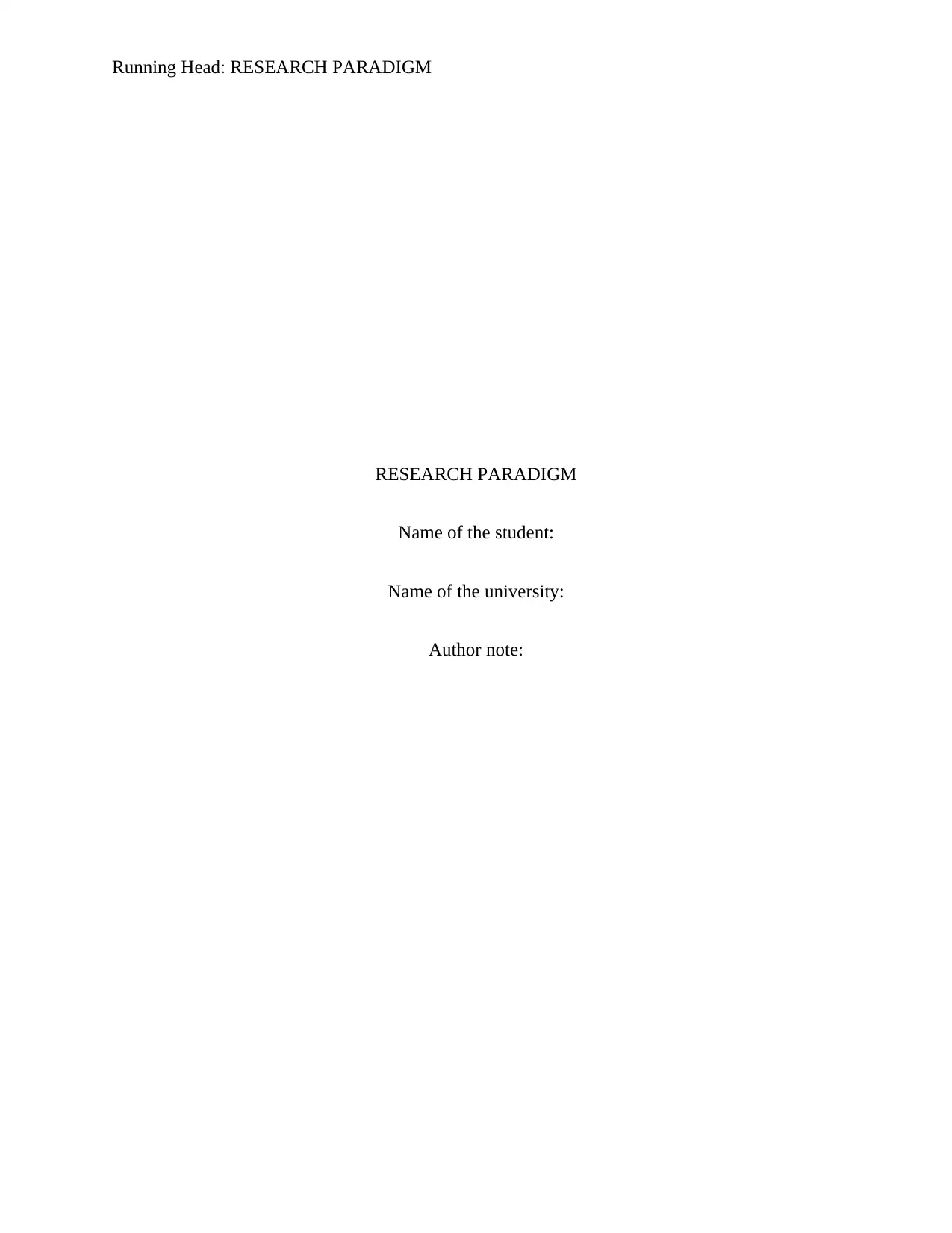
Running Head: RESEARCH PARADIGM
RESEARCH PARADIGM
Name of the student:
Name of the university:
Author note:
RESEARCH PARADIGM
Name of the student:
Name of the university:
Author note:
Paraphrase This Document
Need a fresh take? Get an instant paraphrase of this document with our AI Paraphraser
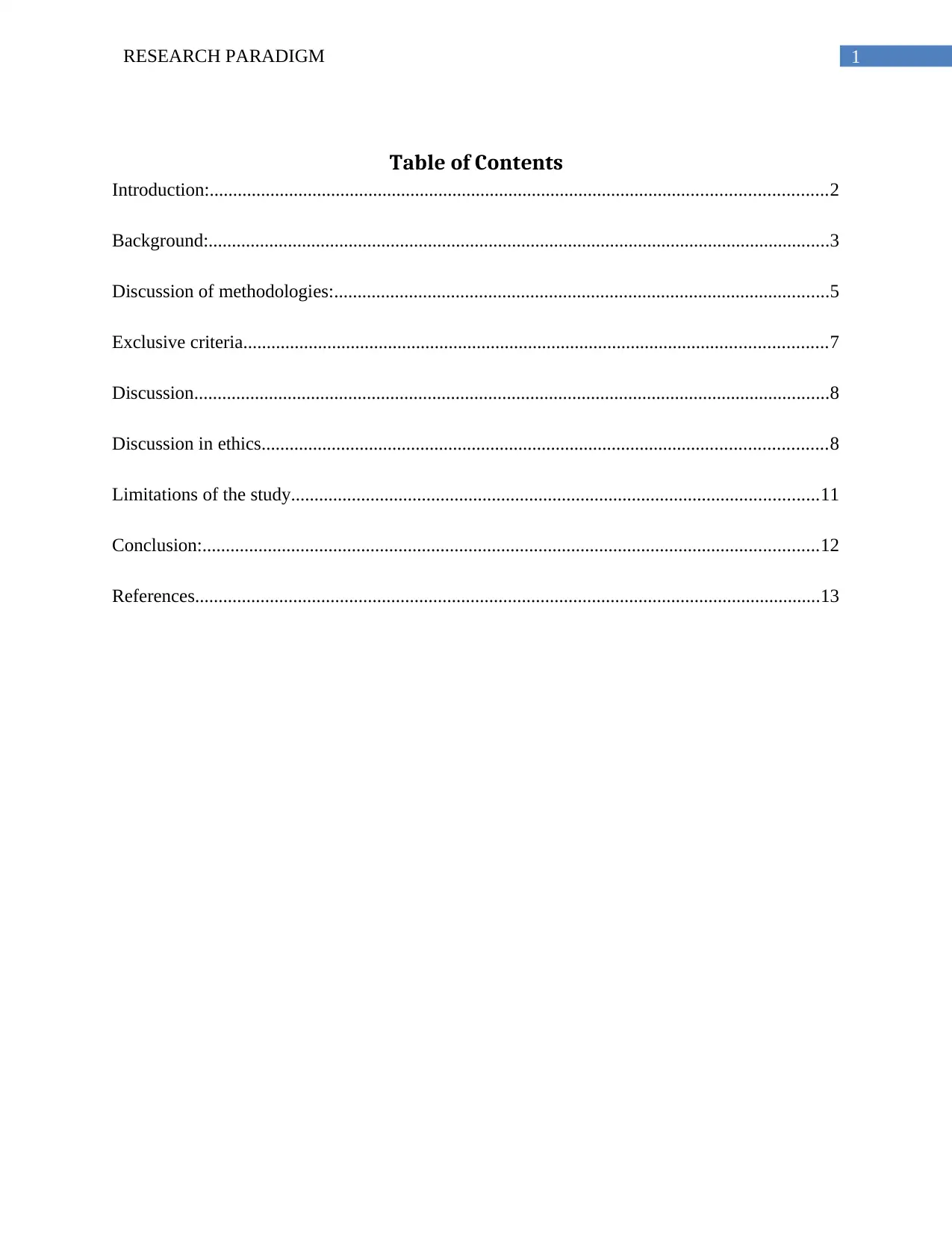
1RESEARCH PARADIGM
Table of Contents
Introduction:....................................................................................................................................2
Background:.....................................................................................................................................3
Discussion of methodologies:..........................................................................................................5
Exclusive criteria.............................................................................................................................7
Discussion........................................................................................................................................8
Discussion in ethics.........................................................................................................................8
Limitations of the study.................................................................................................................11
Conclusion:....................................................................................................................................12
References......................................................................................................................................13
Table of Contents
Introduction:....................................................................................................................................2
Background:.....................................................................................................................................3
Discussion of methodologies:..........................................................................................................5
Exclusive criteria.............................................................................................................................7
Discussion........................................................................................................................................8
Discussion in ethics.........................................................................................................................8
Limitations of the study.................................................................................................................11
Conclusion:....................................................................................................................................12
References......................................................................................................................................13
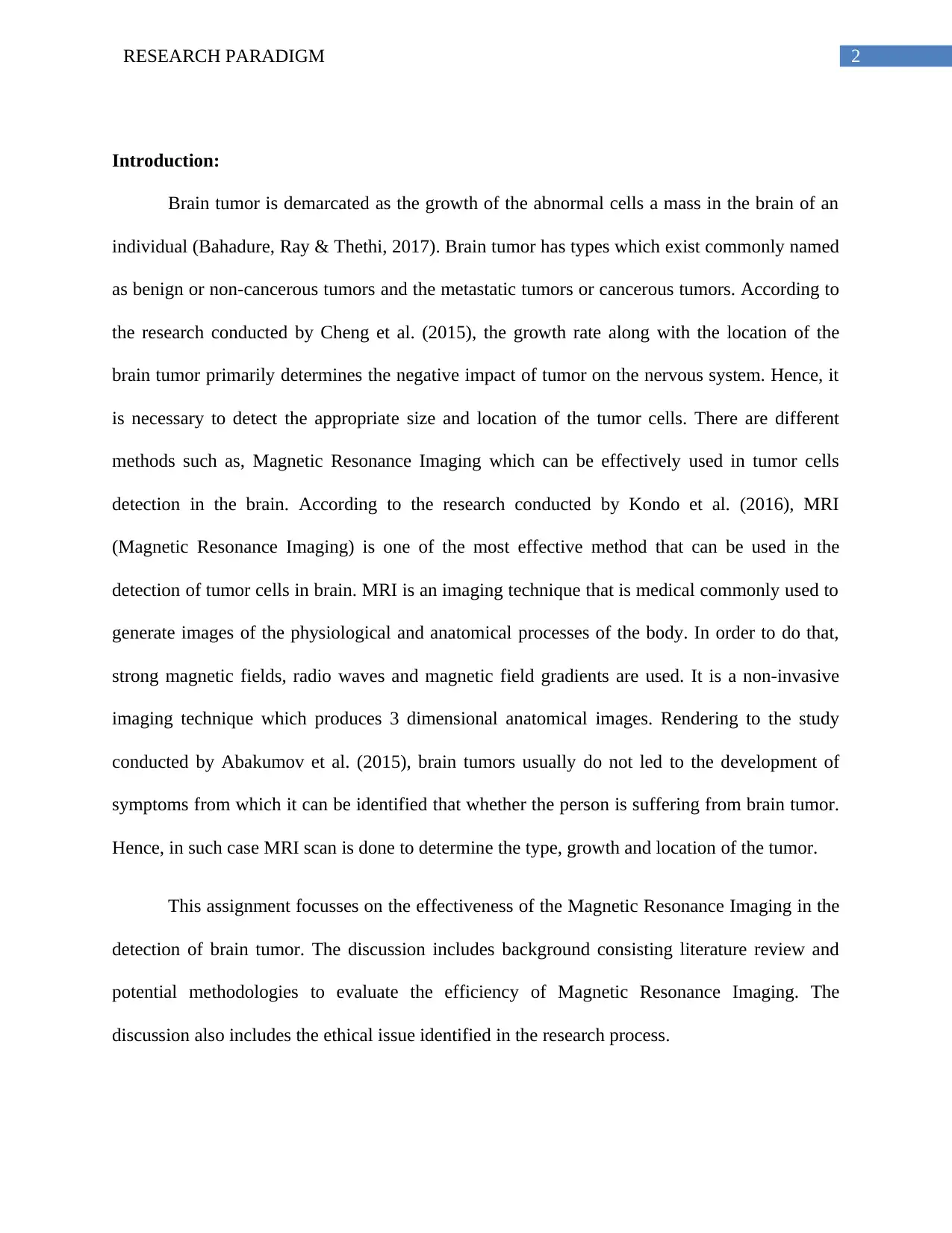
2RESEARCH PARADIGM
Introduction:
Brain tumor is demarcated as the growth of the abnormal cells a mass in the brain of an
individual (Bahadure, Ray & Thethi, 2017). Brain tumor has types which exist commonly named
as benign or non-cancerous tumors and the metastatic tumors or cancerous tumors. According to
the research conducted by Cheng et al. (2015), the growth rate along with the location of the
brain tumor primarily determines the negative impact of tumor on the nervous system. Hence, it
is necessary to detect the appropriate size and location of the tumor cells. There are different
methods such as, Magnetic Resonance Imaging which can be effectively used in tumor cells
detection in the brain. According to the research conducted by Kondo et al. (2016), MRI
(Magnetic Resonance Imaging) is one of the most effective method that can be used in the
detection of tumor cells in brain. MRI is an imaging technique that is medical commonly used to
generate images of the physiological and anatomical processes of the body. In order to do that,
strong magnetic fields, radio waves and magnetic field gradients are used. It is a non-invasive
imaging technique which produces 3 dimensional anatomical images. Rendering to the study
conducted by Abakumov et al. (2015), brain tumors usually do not led to the development of
symptoms from which it can be identified that whether the person is suffering from brain tumor.
Hence, in such case MRI scan is done to determine the type, growth and location of the tumor.
This assignment focusses on the effectiveness of the Magnetic Resonance Imaging in the
detection of brain tumor. The discussion includes background consisting literature review and
potential methodologies to evaluate the efficiency of Magnetic Resonance Imaging. The
discussion also includes the ethical issue identified in the research process.
Introduction:
Brain tumor is demarcated as the growth of the abnormal cells a mass in the brain of an
individual (Bahadure, Ray & Thethi, 2017). Brain tumor has types which exist commonly named
as benign or non-cancerous tumors and the metastatic tumors or cancerous tumors. According to
the research conducted by Cheng et al. (2015), the growth rate along with the location of the
brain tumor primarily determines the negative impact of tumor on the nervous system. Hence, it
is necessary to detect the appropriate size and location of the tumor cells. There are different
methods such as, Magnetic Resonance Imaging which can be effectively used in tumor cells
detection in the brain. According to the research conducted by Kondo et al. (2016), MRI
(Magnetic Resonance Imaging) is one of the most effective method that can be used in the
detection of tumor cells in brain. MRI is an imaging technique that is medical commonly used to
generate images of the physiological and anatomical processes of the body. In order to do that,
strong magnetic fields, radio waves and magnetic field gradients are used. It is a non-invasive
imaging technique which produces 3 dimensional anatomical images. Rendering to the study
conducted by Abakumov et al. (2015), brain tumors usually do not led to the development of
symptoms from which it can be identified that whether the person is suffering from brain tumor.
Hence, in such case MRI scan is done to determine the type, growth and location of the tumor.
This assignment focusses on the effectiveness of the Magnetic Resonance Imaging in the
detection of brain tumor. The discussion includes background consisting literature review and
potential methodologies to evaluate the efficiency of Magnetic Resonance Imaging. The
discussion also includes the ethical issue identified in the research process.
⊘ This is a preview!⊘
Do you want full access?
Subscribe today to unlock all pages.

Trusted by 1+ million students worldwide
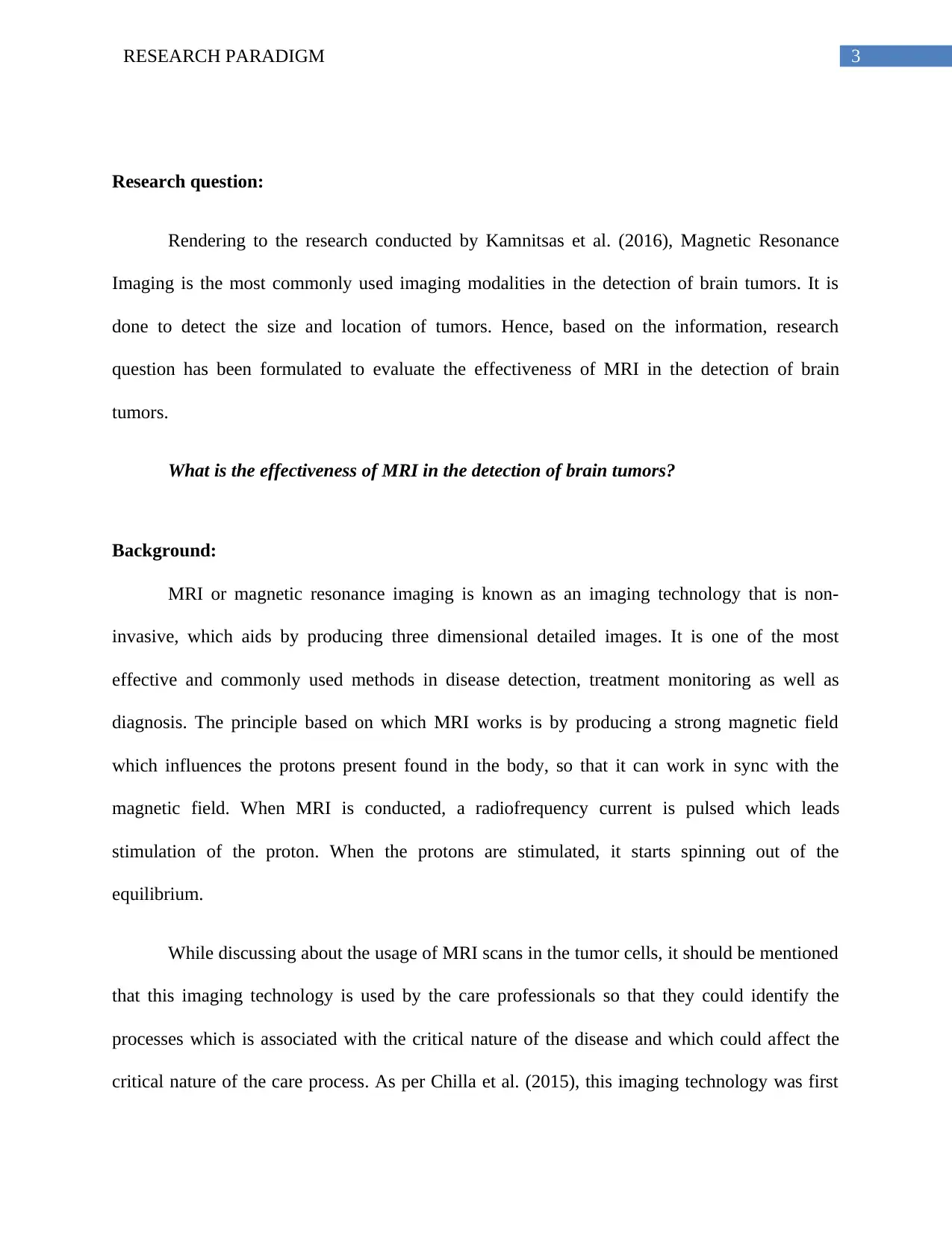
3RESEARCH PARADIGM
Research question:
Rendering to the research conducted by Kamnitsas et al. (2016), Magnetic Resonance
Imaging is the most commonly used imaging modalities in the detection of brain tumors. It is
done to detect the size and location of tumors. Hence, based on the information, research
question has been formulated to evaluate the effectiveness of MRI in the detection of brain
tumors.
What is the effectiveness of MRI in the detection of brain tumors?
Background:
MRI or magnetic resonance imaging is known as an imaging technology that is non-
invasive, which aids by producing three dimensional detailed images. It is one of the most
effective and commonly used methods in disease detection, treatment monitoring as well as
diagnosis. The principle based on which MRI works is by producing a strong magnetic field
which influences the protons present found in the body, so that it can work in sync with the
magnetic field. When MRI is conducted, a radiofrequency current is pulsed which leads
stimulation of the proton. When the protons are stimulated, it starts spinning out of the
equilibrium.
While discussing about the usage of MRI scans in the tumor cells, it should be mentioned
that this imaging technology is used by the care professionals so that they could identify the
processes which is associated with the critical nature of the disease and which could affect the
critical nature of the care process. As per Chilla et al. (2015), this imaging technology was first
Research question:
Rendering to the research conducted by Kamnitsas et al. (2016), Magnetic Resonance
Imaging is the most commonly used imaging modalities in the detection of brain tumors. It is
done to detect the size and location of tumors. Hence, based on the information, research
question has been formulated to evaluate the effectiveness of MRI in the detection of brain
tumors.
What is the effectiveness of MRI in the detection of brain tumors?
Background:
MRI or magnetic resonance imaging is known as an imaging technology that is non-
invasive, which aids by producing three dimensional detailed images. It is one of the most
effective and commonly used methods in disease detection, treatment monitoring as well as
diagnosis. The principle based on which MRI works is by producing a strong magnetic field
which influences the protons present found in the body, so that it can work in sync with the
magnetic field. When MRI is conducted, a radiofrequency current is pulsed which leads
stimulation of the proton. When the protons are stimulated, it starts spinning out of the
equilibrium.
While discussing about the usage of MRI scans in the tumor cells, it should be mentioned
that this imaging technology is used by the care professionals so that they could identify the
processes which is associated with the critical nature of the disease and which could affect the
critical nature of the care process. As per Chilla et al. (2015), this imaging technology was first
Paraphrase This Document
Need a fresh take? Get an instant paraphrase of this document with our AI Paraphraser
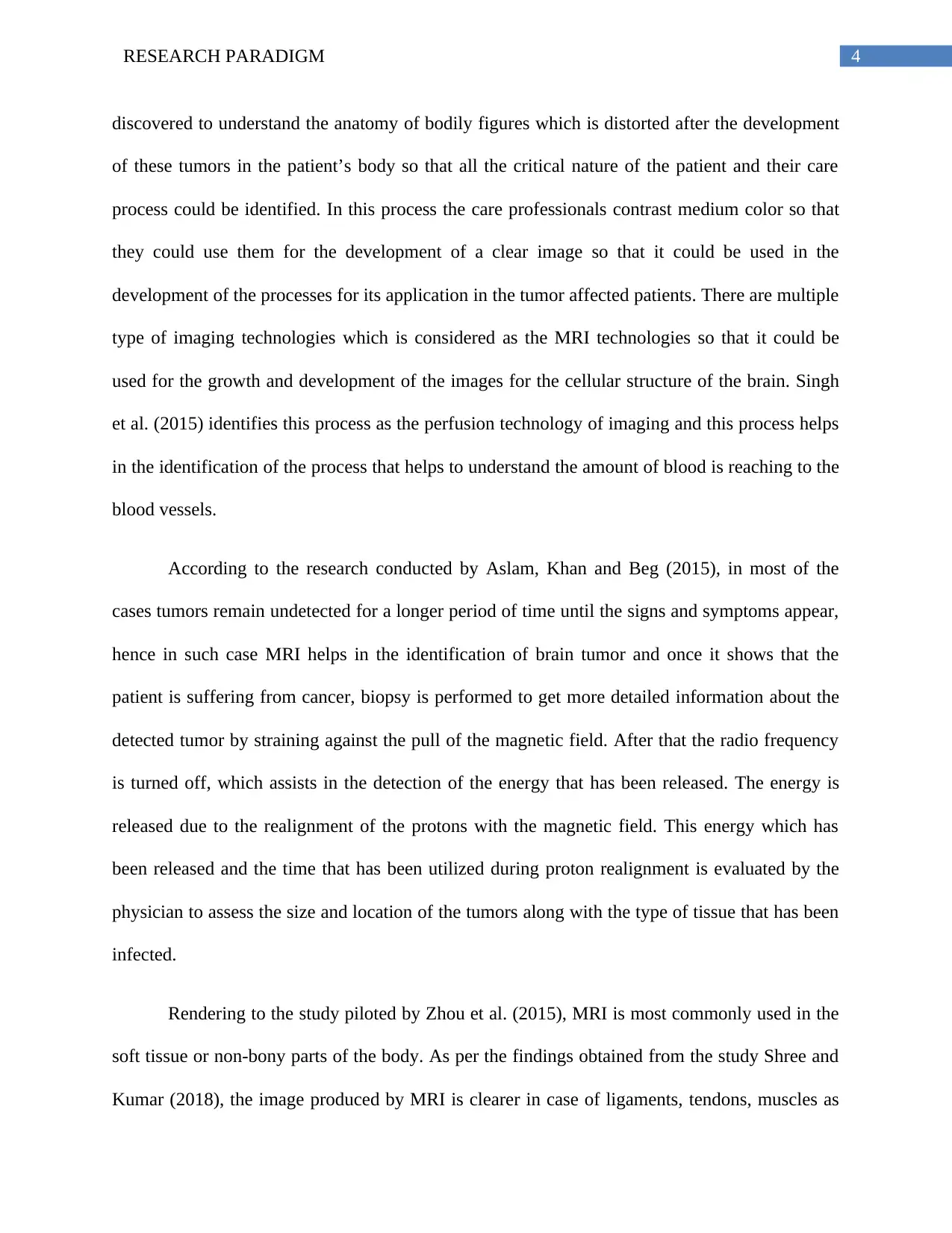
4RESEARCH PARADIGM
discovered to understand the anatomy of bodily figures which is distorted after the development
of these tumors in the patient’s body so that all the critical nature of the patient and their care
process could be identified. In this process the care professionals contrast medium color so that
they could use them for the development of a clear image so that it could be used in the
development of the processes for its application in the tumor affected patients. There are multiple
type of imaging technologies which is considered as the MRI technologies so that it could be
used for the growth and development of the images for the cellular structure of the brain. Singh
et al. (2015) identifies this process as the perfusion technology of imaging and this process helps
in the identification of the process that helps to understand the amount of blood is reaching to the
blood vessels.
According to the research conducted by Aslam, Khan and Beg (2015), in most of the
cases tumors remain undetected for a longer period of time until the signs and symptoms appear,
hence in such case MRI helps in the identification of brain tumor and once it shows that the
patient is suffering from cancer, biopsy is performed to get more detailed information about the
detected tumor by straining against the pull of the magnetic field. After that the radio frequency
is turned off, which assists in the detection of the energy that has been released. The energy is
released due to the realignment of the protons with the magnetic field. This energy which has
been released and the time that has been utilized during proton realignment is evaluated by the
physician to assess the size and location of the tumors along with the type of tissue that has been
infected.
Rendering to the study piloted by Zhou et al. (2015), MRI is most commonly used in the
soft tissue or non-bony parts of the body. As per the findings obtained from the study Shree and
Kumar (2018), the image produced by MRI is clearer in case of ligaments, tendons, muscles as
discovered to understand the anatomy of bodily figures which is distorted after the development
of these tumors in the patient’s body so that all the critical nature of the patient and their care
process could be identified. In this process the care professionals contrast medium color so that
they could use them for the development of a clear image so that it could be used in the
development of the processes for its application in the tumor affected patients. There are multiple
type of imaging technologies which is considered as the MRI technologies so that it could be
used for the growth and development of the images for the cellular structure of the brain. Singh
et al. (2015) identifies this process as the perfusion technology of imaging and this process helps
in the identification of the process that helps to understand the amount of blood is reaching to the
blood vessels.
According to the research conducted by Aslam, Khan and Beg (2015), in most of the
cases tumors remain undetected for a longer period of time until the signs and symptoms appear,
hence in such case MRI helps in the identification of brain tumor and once it shows that the
patient is suffering from cancer, biopsy is performed to get more detailed information about the
detected tumor by straining against the pull of the magnetic field. After that the radio frequency
is turned off, which assists in the detection of the energy that has been released. The energy is
released due to the realignment of the protons with the magnetic field. This energy which has
been released and the time that has been utilized during proton realignment is evaluated by the
physician to assess the size and location of the tumors along with the type of tissue that has been
infected.
Rendering to the study piloted by Zhou et al. (2015), MRI is most commonly used in the
soft tissue or non-bony parts of the body. As per the findings obtained from the study Shree and
Kumar (2018), the image produced by MRI is clearer in case of ligaments, tendons, muscles as
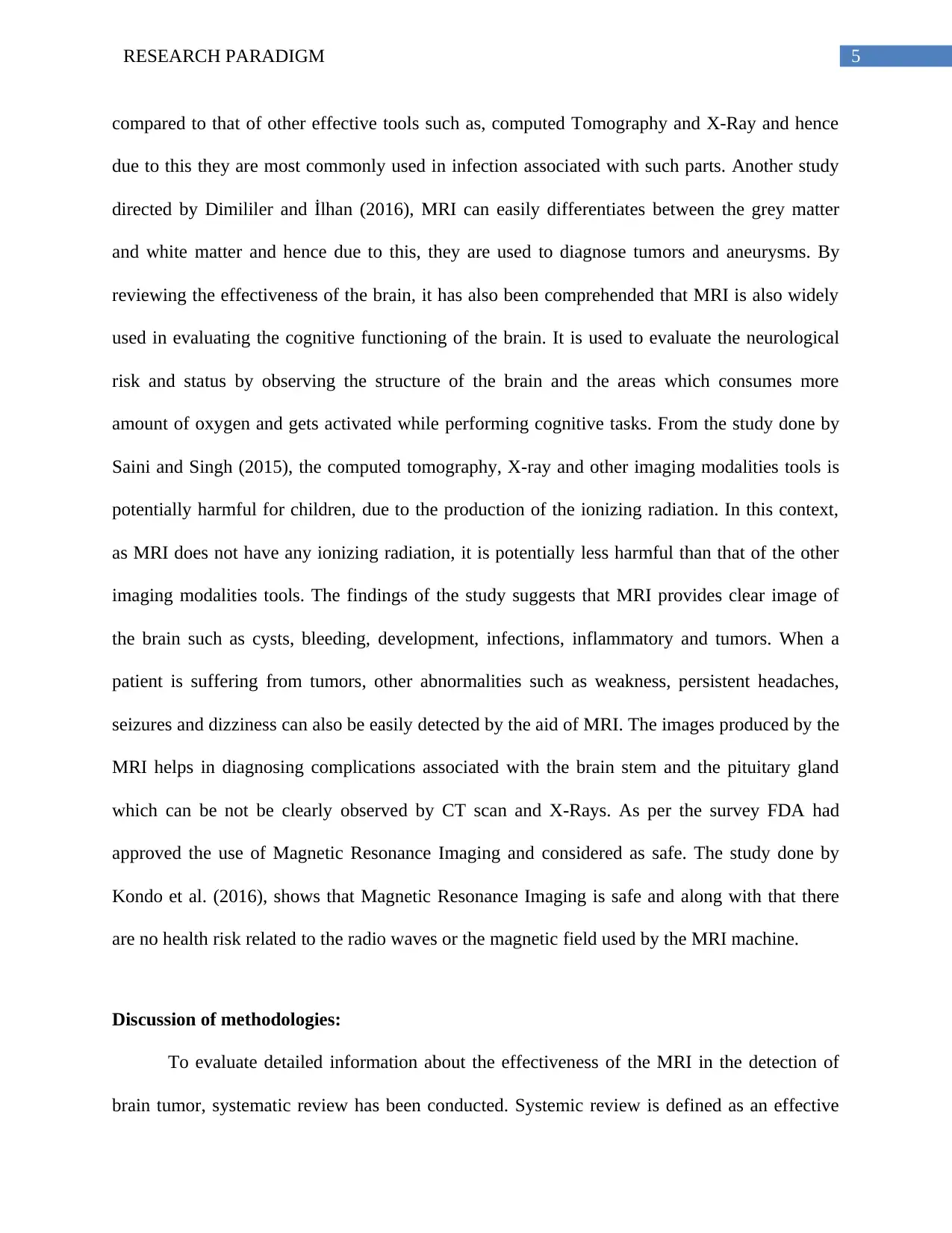
5RESEARCH PARADIGM
compared to that of other effective tools such as, computed Tomography and X-Ray and hence
due to this they are most commonly used in infection associated with such parts. Another study
directed by Dimililer and İlhan (2016), MRI can easily differentiates between the grey matter
and white matter and hence due to this, they are used to diagnose tumors and aneurysms. By
reviewing the effectiveness of the brain, it has also been comprehended that MRI is also widely
used in evaluating the cognitive functioning of the brain. It is used to evaluate the neurological
risk and status by observing the structure of the brain and the areas which consumes more
amount of oxygen and gets activated while performing cognitive tasks. From the study done by
Saini and Singh (2015), the computed tomography, X-ray and other imaging modalities tools is
potentially harmful for children, due to the production of the ionizing radiation. In this context,
as MRI does not have any ionizing radiation, it is potentially less harmful than that of the other
imaging modalities tools. The findings of the study suggests that MRI provides clear image of
the brain such as cysts, bleeding, development, infections, inflammatory and tumors. When a
patient is suffering from tumors, other abnormalities such as weakness, persistent headaches,
seizures and dizziness can also be easily detected by the aid of MRI. The images produced by the
MRI helps in diagnosing complications associated with the brain stem and the pituitary gland
which can be not be clearly observed by CT scan and X-Rays. As per the survey FDA had
approved the use of Magnetic Resonance Imaging and considered as safe. The study done by
Kondo et al. (2016), shows that Magnetic Resonance Imaging is safe and along with that there
are no health risk related to the radio waves or the magnetic field used by the MRI machine.
Discussion of methodologies:
To evaluate detailed information about the effectiveness of the MRI in the detection of
brain tumor, systematic review has been conducted. Systemic review is defined as an effective
compared to that of other effective tools such as, computed Tomography and X-Ray and hence
due to this they are most commonly used in infection associated with such parts. Another study
directed by Dimililer and İlhan (2016), MRI can easily differentiates between the grey matter
and white matter and hence due to this, they are used to diagnose tumors and aneurysms. By
reviewing the effectiveness of the brain, it has also been comprehended that MRI is also widely
used in evaluating the cognitive functioning of the brain. It is used to evaluate the neurological
risk and status by observing the structure of the brain and the areas which consumes more
amount of oxygen and gets activated while performing cognitive tasks. From the study done by
Saini and Singh (2015), the computed tomography, X-ray and other imaging modalities tools is
potentially harmful for children, due to the production of the ionizing radiation. In this context,
as MRI does not have any ionizing radiation, it is potentially less harmful than that of the other
imaging modalities tools. The findings of the study suggests that MRI provides clear image of
the brain such as cysts, bleeding, development, infections, inflammatory and tumors. When a
patient is suffering from tumors, other abnormalities such as weakness, persistent headaches,
seizures and dizziness can also be easily detected by the aid of MRI. The images produced by the
MRI helps in diagnosing complications associated with the brain stem and the pituitary gland
which can be not be clearly observed by CT scan and X-Rays. As per the survey FDA had
approved the use of Magnetic Resonance Imaging and considered as safe. The study done by
Kondo et al. (2016), shows that Magnetic Resonance Imaging is safe and along with that there
are no health risk related to the radio waves or the magnetic field used by the MRI machine.
Discussion of methodologies:
To evaluate detailed information about the effectiveness of the MRI in the detection of
brain tumor, systematic review has been conducted. Systemic review is defined as an effective
⊘ This is a preview!⊘
Do you want full access?
Subscribe today to unlock all pages.

Trusted by 1+ million students worldwide
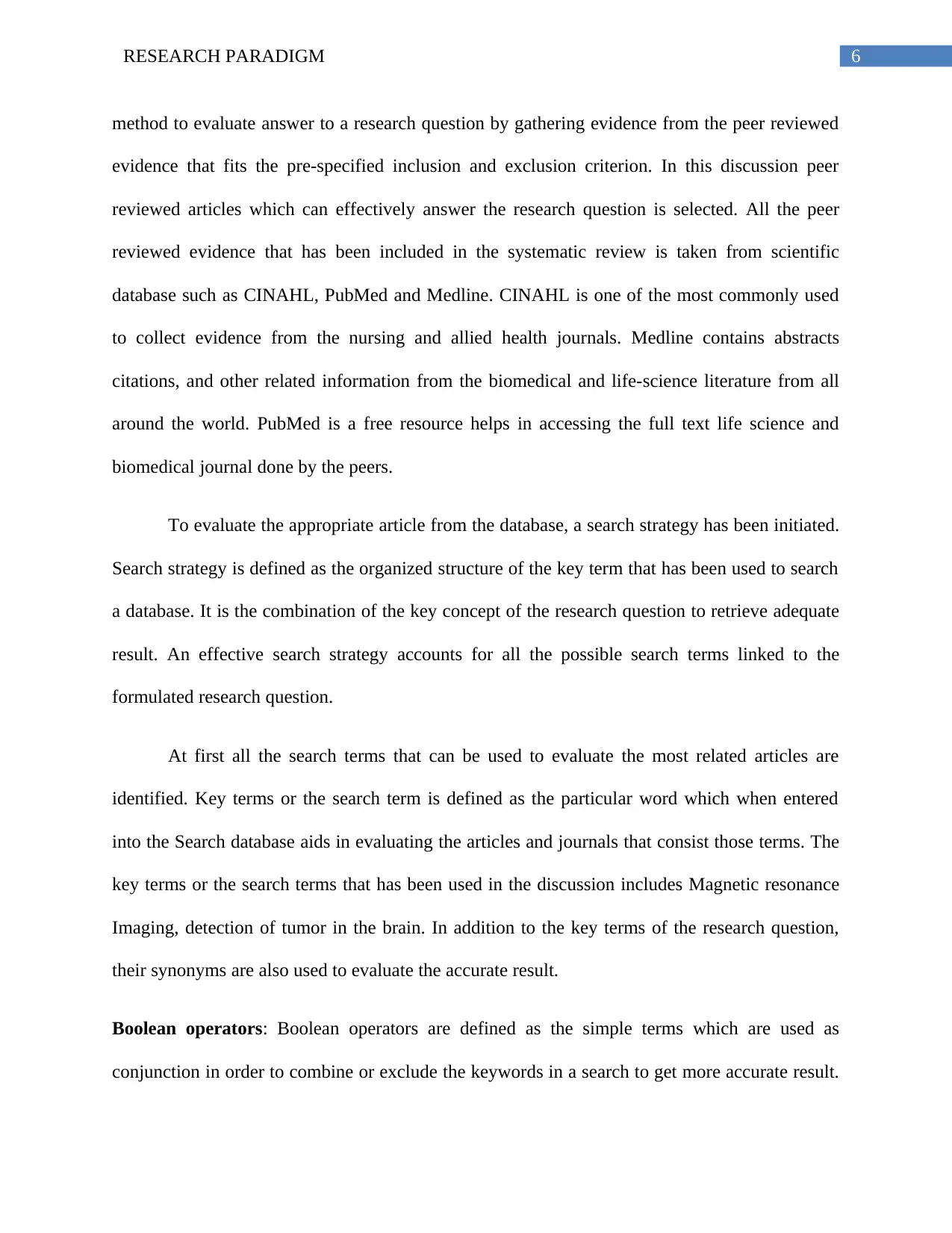
6RESEARCH PARADIGM
method to evaluate answer to a research question by gathering evidence from the peer reviewed
evidence that fits the pre-specified inclusion and exclusion criterion. In this discussion peer
reviewed articles which can effectively answer the research question is selected. All the peer
reviewed evidence that has been included in the systematic review is taken from scientific
database such as CINAHL, PubMed and Medline. CINAHL is one of the most commonly used
to collect evidence from the nursing and allied health journals. Medline contains abstracts
citations, and other related information from the biomedical and life-science literature from all
around the world. PubMed is a free resource helps in accessing the full text life science and
biomedical journal done by the peers.
To evaluate the appropriate article from the database, a search strategy has been initiated.
Search strategy is defined as the organized structure of the key term that has been used to search
a database. It is the combination of the key concept of the research question to retrieve adequate
result. An effective search strategy accounts for all the possible search terms linked to the
formulated research question.
At first all the search terms that can be used to evaluate the most related articles are
identified. Key terms or the search term is defined as the particular word which when entered
into the Search database aids in evaluating the articles and journals that consist those terms. The
key terms or the search terms that has been used in the discussion includes Magnetic resonance
Imaging, detection of tumor in the brain. In addition to the key terms of the research question,
their synonyms are also used to evaluate the accurate result.
Boolean operators: Boolean operators are defined as the simple terms which are used as
conjunction in order to combine or exclude the keywords in a search to get more accurate result.
method to evaluate answer to a research question by gathering evidence from the peer reviewed
evidence that fits the pre-specified inclusion and exclusion criterion. In this discussion peer
reviewed articles which can effectively answer the research question is selected. All the peer
reviewed evidence that has been included in the systematic review is taken from scientific
database such as CINAHL, PubMed and Medline. CINAHL is one of the most commonly used
to collect evidence from the nursing and allied health journals. Medline contains abstracts
citations, and other related information from the biomedical and life-science literature from all
around the world. PubMed is a free resource helps in accessing the full text life science and
biomedical journal done by the peers.
To evaluate the appropriate article from the database, a search strategy has been initiated.
Search strategy is defined as the organized structure of the key term that has been used to search
a database. It is the combination of the key concept of the research question to retrieve adequate
result. An effective search strategy accounts for all the possible search terms linked to the
formulated research question.
At first all the search terms that can be used to evaluate the most related articles are
identified. Key terms or the search term is defined as the particular word which when entered
into the Search database aids in evaluating the articles and journals that consist those terms. The
key terms or the search terms that has been used in the discussion includes Magnetic resonance
Imaging, detection of tumor in the brain. In addition to the key terms of the research question,
their synonyms are also used to evaluate the accurate result.
Boolean operators: Boolean operators are defined as the simple terms which are used as
conjunction in order to combine or exclude the keywords in a search to get more accurate result.
Paraphrase This Document
Need a fresh take? Get an instant paraphrase of this document with our AI Paraphraser
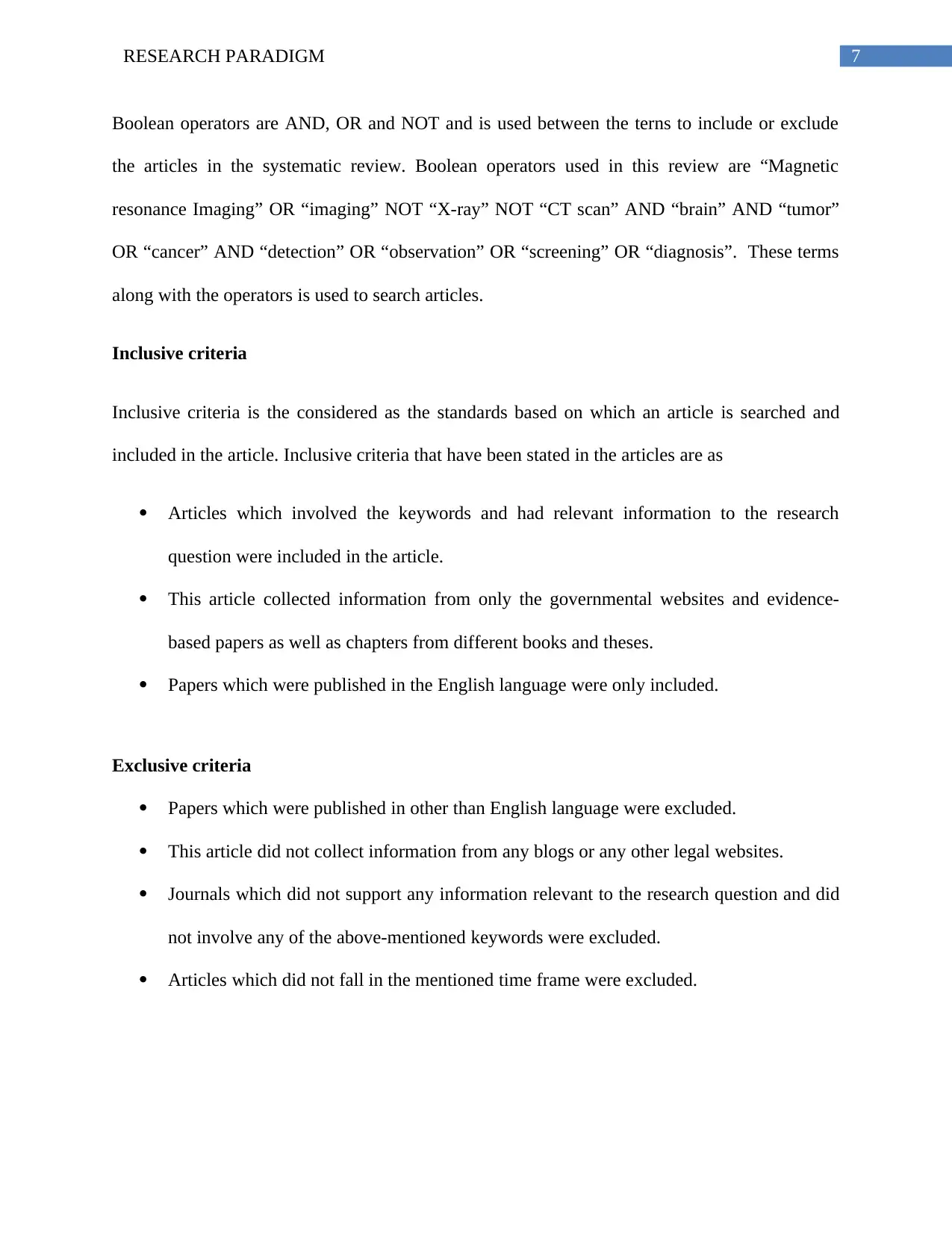
7RESEARCH PARADIGM
Boolean operators are AND, OR and NOT and is used between the terns to include or exclude
the articles in the systematic review. Boolean operators used in this review are “Magnetic
resonance Imaging” OR “imaging” NOT “X-ray” NOT “CT scan” AND “brain” AND “tumor”
OR “cancer” AND “detection” OR “observation” OR “screening” OR “diagnosis”. These terms
along with the operators is used to search articles.
Inclusive criteria
Inclusive criteria is the considered as the standards based on which an article is searched and
included in the article. Inclusive criteria that have been stated in the articles are as
Articles which involved the keywords and had relevant information to the research
question were included in the article.
This article collected information from only the governmental websites and evidence-
based papers as well as chapters from different books and theses.
Papers which were published in the English language were only included.
Exclusive criteria
Papers which were published in other than English language were excluded.
This article did not collect information from any blogs or any other legal websites.
Journals which did not support any information relevant to the research question and did
not involve any of the above-mentioned keywords were excluded.
Articles which did not fall in the mentioned time frame were excluded.
Boolean operators are AND, OR and NOT and is used between the terns to include or exclude
the articles in the systematic review. Boolean operators used in this review are “Magnetic
resonance Imaging” OR “imaging” NOT “X-ray” NOT “CT scan” AND “brain” AND “tumor”
OR “cancer” AND “detection” OR “observation” OR “screening” OR “diagnosis”. These terms
along with the operators is used to search articles.
Inclusive criteria
Inclusive criteria is the considered as the standards based on which an article is searched and
included in the article. Inclusive criteria that have been stated in the articles are as
Articles which involved the keywords and had relevant information to the research
question were included in the article.
This article collected information from only the governmental websites and evidence-
based papers as well as chapters from different books and theses.
Papers which were published in the English language were only included.
Exclusive criteria
Papers which were published in other than English language were excluded.
This article did not collect information from any blogs or any other legal websites.
Journals which did not support any information relevant to the research question and did
not involve any of the above-mentioned keywords were excluded.
Articles which did not fall in the mentioned time frame were excluded.
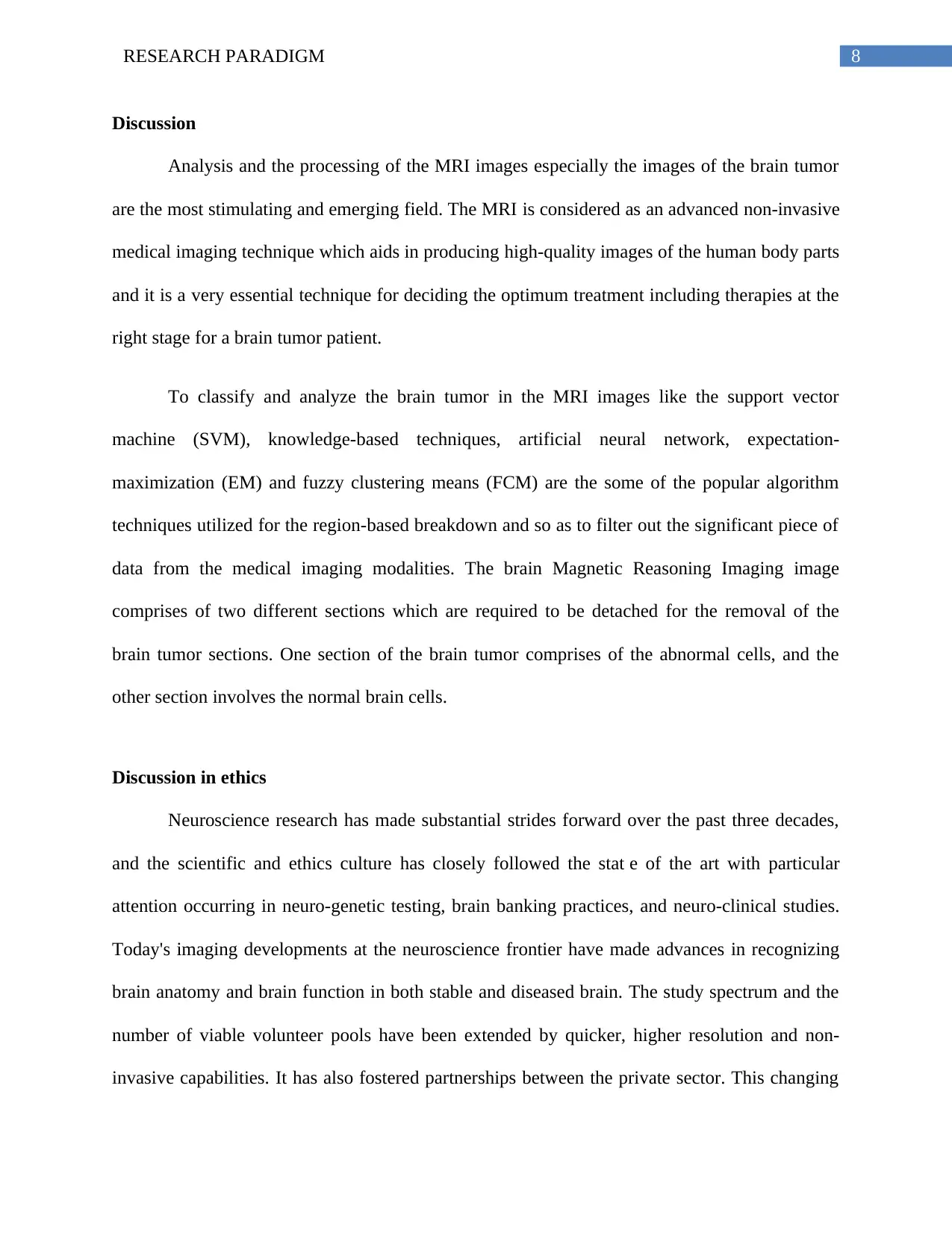
8RESEARCH PARADIGM
Discussion
Analysis and the processing of the MRI images especially the images of the brain tumor
are the most stimulating and emerging field. The MRI is considered as an advanced non-invasive
medical imaging technique which aids in producing high-quality images of the human body parts
and it is a very essential technique for deciding the optimum treatment including therapies at the
right stage for a brain tumor patient.
To classify and analyze the brain tumor in the MRI images like the support vector
machine (SVM), knowledge-based techniques, artificial neural network, expectation-
maximization (EM) and fuzzy clustering means (FCM) are the some of the popular algorithm
techniques utilized for the region-based breakdown and so as to filter out the significant piece of
data from the medical imaging modalities. The brain Magnetic Reasoning Imaging image
comprises of two different sections which are required to be detached for the removal of the
brain tumor sections. One section of the brain tumor comprises of the abnormal cells, and the
other section involves the normal brain cells.
Discussion in ethics
Neuroscience research has made substantial strides forward over the past three decades,
and the scientific and ethics culture has closely followed the stat e of the art with particular
attention occurring in neuro-genetic testing, brain banking practices, and neuro-clinical studies.
Today's imaging developments at the neuroscience frontier have made advances in recognizing
brain anatomy and brain function in both stable and diseased brain. The study spectrum and the
number of viable volunteer pools have been extended by quicker, higher resolution and non-
invasive capabilities. It has also fostered partnerships between the private sector. This changing
Discussion
Analysis and the processing of the MRI images especially the images of the brain tumor
are the most stimulating and emerging field. The MRI is considered as an advanced non-invasive
medical imaging technique which aids in producing high-quality images of the human body parts
and it is a very essential technique for deciding the optimum treatment including therapies at the
right stage for a brain tumor patient.
To classify and analyze the brain tumor in the MRI images like the support vector
machine (SVM), knowledge-based techniques, artificial neural network, expectation-
maximization (EM) and fuzzy clustering means (FCM) are the some of the popular algorithm
techniques utilized for the region-based breakdown and so as to filter out the significant piece of
data from the medical imaging modalities. The brain Magnetic Reasoning Imaging image
comprises of two different sections which are required to be detached for the removal of the
brain tumor sections. One section of the brain tumor comprises of the abnormal cells, and the
other section involves the normal brain cells.
Discussion in ethics
Neuroscience research has made substantial strides forward over the past three decades,
and the scientific and ethics culture has closely followed the stat e of the art with particular
attention occurring in neuro-genetic testing, brain banking practices, and neuro-clinical studies.
Today's imaging developments at the neuroscience frontier have made advances in recognizing
brain anatomy and brain function in both stable and diseased brain. The study spectrum and the
number of viable volunteer pools have been extended by quicker, higher resolution and non-
invasive capabilities. It has also fostered partnerships between the private sector. This changing
⊘ This is a preview!⊘
Do you want full access?
Subscribe today to unlock all pages.

Trusted by 1+ million students worldwide
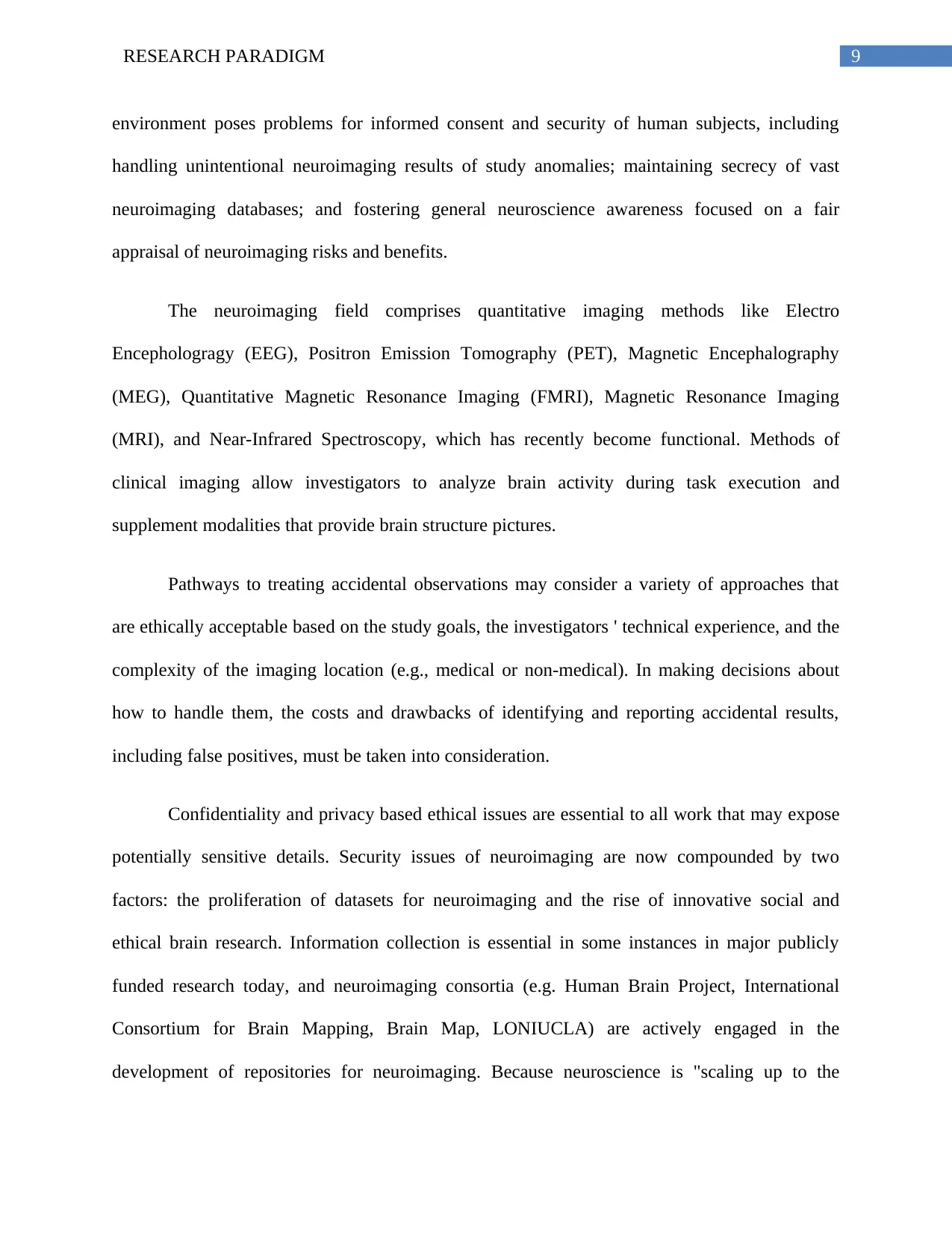
9RESEARCH PARADIGM
environment poses problems for informed consent and security of human subjects, including
handling unintentional neuroimaging results of study anomalies; maintaining secrecy of vast
neuroimaging databases; and fostering general neuroscience awareness focused on a fair
appraisal of neuroimaging risks and benefits.
The neuroimaging field comprises quantitative imaging methods like Electro
Encephologragy (EEG), Positron Emission Tomography (PET), Magnetic Encephalography
(MEG), Quantitative Magnetic Resonance Imaging (FMRI), Magnetic Resonance Imaging
(MRI), and Near-Infrared Spectroscopy, which has recently become functional. Methods of
clinical imaging allow investigators to analyze brain activity during task execution and
supplement modalities that provide brain structure pictures.
Pathways to treating accidental observations may consider a variety of approaches that
are ethically acceptable based on the study goals, the investigators ' technical experience, and the
complexity of the imaging location (e.g., medical or non-medical). In making decisions about
how to handle them, the costs and drawbacks of identifying and reporting accidental results,
including false positives, must be taken into consideration.
Confidentiality and privacy based ethical issues are essential to all work that may expose
potentially sensitive details. Security issues of neuroimaging are now compounded by two
factors: the proliferation of datasets for neuroimaging and the rise of innovative social and
ethical brain research. Information collection is essential in some instances in major publicly
funded research today, and neuroimaging consortia (e.g. Human Brain Project, International
Consortium for Brain Mapping, Brain Map, LONIUCLA) are actively engaged in the
development of repositories for neuroimaging. Because neuroscience is "scaling up to the
environment poses problems for informed consent and security of human subjects, including
handling unintentional neuroimaging results of study anomalies; maintaining secrecy of vast
neuroimaging databases; and fostering general neuroscience awareness focused on a fair
appraisal of neuroimaging risks and benefits.
The neuroimaging field comprises quantitative imaging methods like Electro
Encephologragy (EEG), Positron Emission Tomography (PET), Magnetic Encephalography
(MEG), Quantitative Magnetic Resonance Imaging (FMRI), Magnetic Resonance Imaging
(MRI), and Near-Infrared Spectroscopy, which has recently become functional. Methods of
clinical imaging allow investigators to analyze brain activity during task execution and
supplement modalities that provide brain structure pictures.
Pathways to treating accidental observations may consider a variety of approaches that
are ethically acceptable based on the study goals, the investigators ' technical experience, and the
complexity of the imaging location (e.g., medical or non-medical). In making decisions about
how to handle them, the costs and drawbacks of identifying and reporting accidental results,
including false positives, must be taken into consideration.
Confidentiality and privacy based ethical issues are essential to all work that may expose
potentially sensitive details. Security issues of neuroimaging are now compounded by two
factors: the proliferation of datasets for neuroimaging and the rise of innovative social and
ethical brain research. Information collection is essential in some instances in major publicly
funded research today, and neuroimaging consortia (e.g. Human Brain Project, International
Consortium for Brain Mapping, Brain Map, LONIUCLA) are actively engaged in the
development of repositories for neuroimaging. Because neuroscience is "scaling up to the
Paraphrase This Document
Need a fresh take? Get an instant paraphrase of this document with our AI Paraphraser
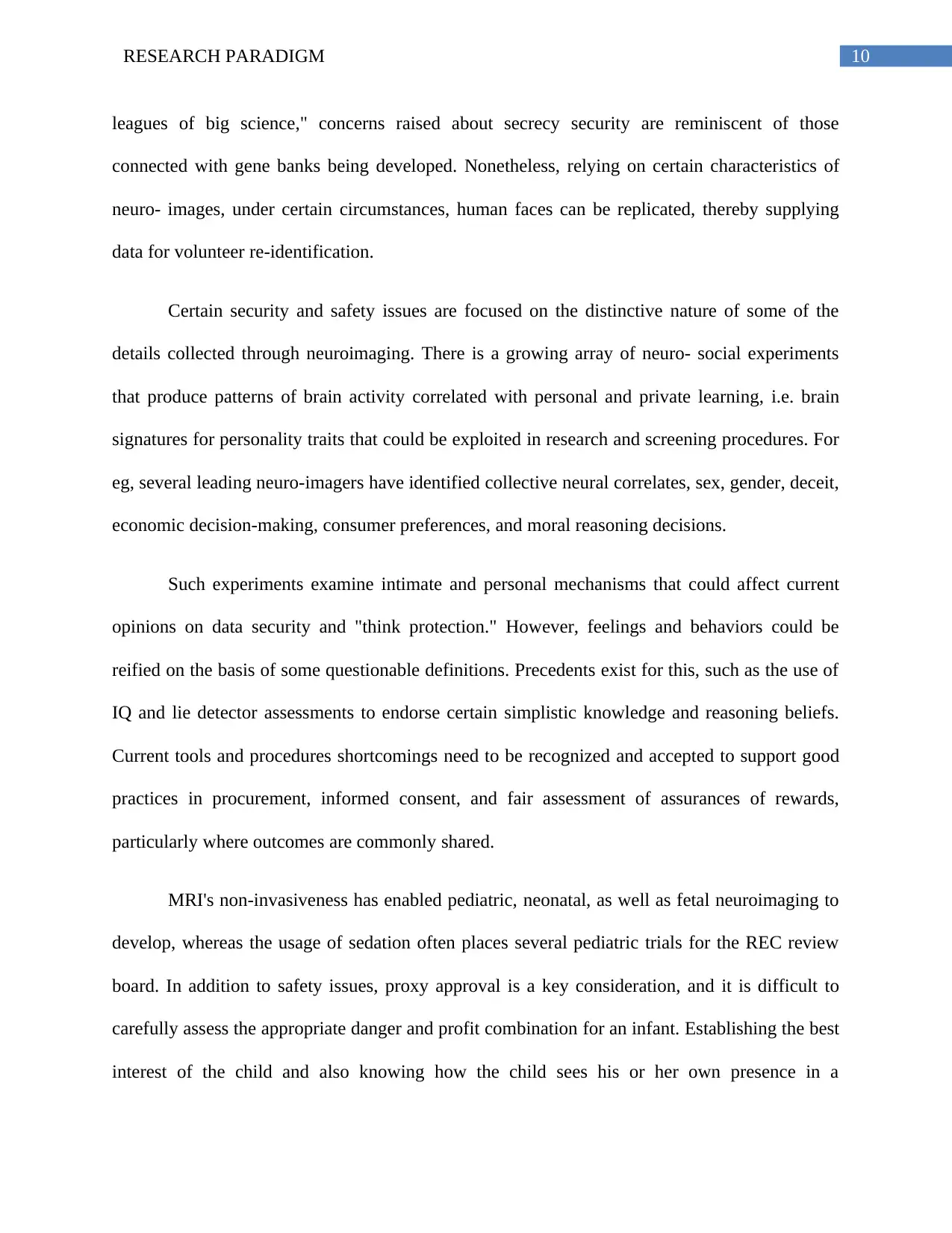
10RESEARCH PARADIGM
leagues of big science," concerns raised about secrecy security are reminiscent of those
connected with gene banks being developed. Nonetheless, relying on certain characteristics of
neuro- images, under certain circumstances, human faces can be replicated, thereby supplying
data for volunteer re-identification.
Certain security and safety issues are focused on the distinctive nature of some of the
details collected through neuroimaging. There is a growing array of neuro- social experiments
that produce patterns of brain activity correlated with personal and private learning, i.e. brain
signatures for personality traits that could be exploited in research and screening procedures. For
eg, several leading neuro-imagers have identified collective neural correlates, sex, gender, deceit,
economic decision-making, consumer preferences, and moral reasoning decisions.
Such experiments examine intimate and personal mechanisms that could affect current
opinions on data security and "think protection." However, feelings and behaviors could be
reified on the basis of some questionable definitions. Precedents exist for this, such as the use of
IQ and lie detector assessments to endorse certain simplistic knowledge and reasoning beliefs.
Current tools and procedures shortcomings need to be recognized and accepted to support good
practices in procurement, informed consent, and fair assessment of assurances of rewards,
particularly where outcomes are commonly shared.
MRI's non-invasiveness has enabled pediatric, neonatal, as well as fetal neuroimaging to
develop, whereas the usage of sedation often places several pediatric trials for the REC review
board. In addition to safety issues, proxy approval is a key consideration, and it is difficult to
carefully assess the appropriate danger and profit combination for an infant. Establishing the best
interest of the child and also knowing how the child sees his or her own presence in a
leagues of big science," concerns raised about secrecy security are reminiscent of those
connected with gene banks being developed. Nonetheless, relying on certain characteristics of
neuro- images, under certain circumstances, human faces can be replicated, thereby supplying
data for volunteer re-identification.
Certain security and safety issues are focused on the distinctive nature of some of the
details collected through neuroimaging. There is a growing array of neuro- social experiments
that produce patterns of brain activity correlated with personal and private learning, i.e. brain
signatures for personality traits that could be exploited in research and screening procedures. For
eg, several leading neuro-imagers have identified collective neural correlates, sex, gender, deceit,
economic decision-making, consumer preferences, and moral reasoning decisions.
Such experiments examine intimate and personal mechanisms that could affect current
opinions on data security and "think protection." However, feelings and behaviors could be
reified on the basis of some questionable definitions. Precedents exist for this, such as the use of
IQ and lie detector assessments to endorse certain simplistic knowledge and reasoning beliefs.
Current tools and procedures shortcomings need to be recognized and accepted to support good
practices in procurement, informed consent, and fair assessment of assurances of rewards,
particularly where outcomes are commonly shared.
MRI's non-invasiveness has enabled pediatric, neonatal, as well as fetal neuroimaging to
develop, whereas the usage of sedation often places several pediatric trials for the REC review
board. In addition to safety issues, proxy approval is a key consideration, and it is difficult to
carefully assess the appropriate danger and profit combination for an infant. Establishing the best
interest of the child and also knowing how the child sees his or her own presence in a
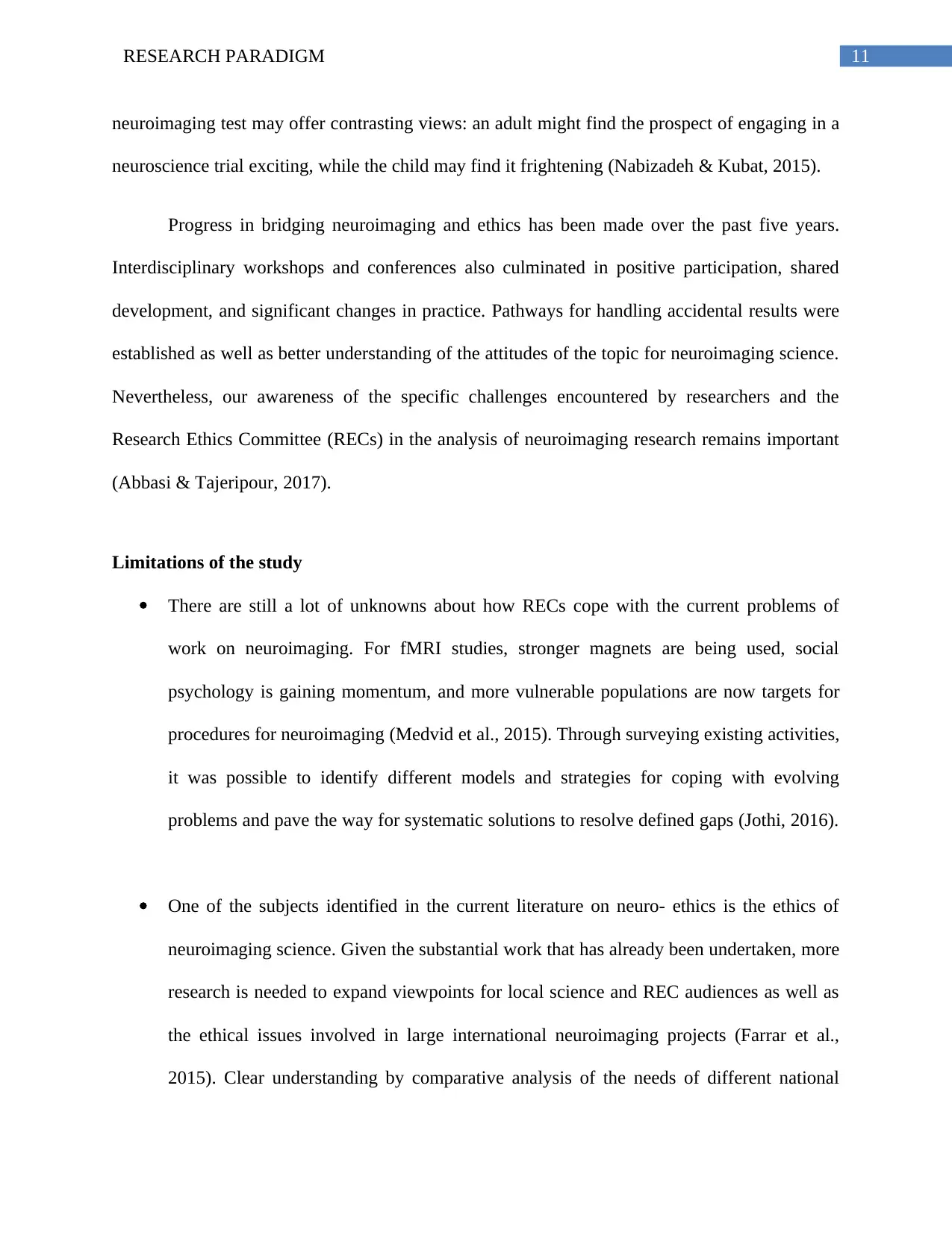
11RESEARCH PARADIGM
neuroimaging test may offer contrasting views: an adult might find the prospect of engaging in a
neuroscience trial exciting, while the child may find it frightening (Nabizadeh & Kubat, 2015).
Progress in bridging neuroimaging and ethics has been made over the past five years.
Interdisciplinary workshops and conferences also culminated in positive participation, shared
development, and significant changes in practice. Pathways for handling accidental results were
established as well as better understanding of the attitudes of the topic for neuroimaging science.
Nevertheless, our awareness of the specific challenges encountered by researchers and the
Research Ethics Committee (RECs) in the analysis of neuroimaging research remains important
(Abbasi & Tajeripour, 2017).
Limitations of the study
There are still a lot of unknowns about how RECs cope with the current problems of
work on neuroimaging. For fMRI studies, stronger magnets are being used, social
psychology is gaining momentum, and more vulnerable populations are now targets for
procedures for neuroimaging (Medvid et al., 2015). Through surveying existing activities,
it was possible to identify different models and strategies for coping with evolving
problems and pave the way for systematic solutions to resolve defined gaps (Jothi, 2016).
One of the subjects identified in the current literature on neuro- ethics is the ethics of
neuroimaging science. Given the substantial work that has already been undertaken, more
research is needed to expand viewpoints for local science and REC audiences as well as
the ethical issues involved in large international neuroimaging projects (Farrar et al.,
2015). Clear understanding by comparative analysis of the needs of different national
neuroimaging test may offer contrasting views: an adult might find the prospect of engaging in a
neuroscience trial exciting, while the child may find it frightening (Nabizadeh & Kubat, 2015).
Progress in bridging neuroimaging and ethics has been made over the past five years.
Interdisciplinary workshops and conferences also culminated in positive participation, shared
development, and significant changes in practice. Pathways for handling accidental results were
established as well as better understanding of the attitudes of the topic for neuroimaging science.
Nevertheless, our awareness of the specific challenges encountered by researchers and the
Research Ethics Committee (RECs) in the analysis of neuroimaging research remains important
(Abbasi & Tajeripour, 2017).
Limitations of the study
There are still a lot of unknowns about how RECs cope with the current problems of
work on neuroimaging. For fMRI studies, stronger magnets are being used, social
psychology is gaining momentum, and more vulnerable populations are now targets for
procedures for neuroimaging (Medvid et al., 2015). Through surveying existing activities,
it was possible to identify different models and strategies for coping with evolving
problems and pave the way for systematic solutions to resolve defined gaps (Jothi, 2016).
One of the subjects identified in the current literature on neuro- ethics is the ethics of
neuroimaging science. Given the substantial work that has already been undertaken, more
research is needed to expand viewpoints for local science and REC audiences as well as
the ethical issues involved in large international neuroimaging projects (Farrar et al.,
2015). Clear understanding by comparative analysis of the needs of different national
⊘ This is a preview!⊘
Do you want full access?
Subscribe today to unlock all pages.

Trusted by 1+ million students worldwide
1 out of 16
Related Documents
Your All-in-One AI-Powered Toolkit for Academic Success.
+13062052269
info@desklib.com
Available 24*7 on WhatsApp / Email
![[object Object]](/_next/static/media/star-bottom.7253800d.svg)
Unlock your academic potential
Copyright © 2020–2025 A2Z Services. All Rights Reserved. Developed and managed by ZUCOL.





